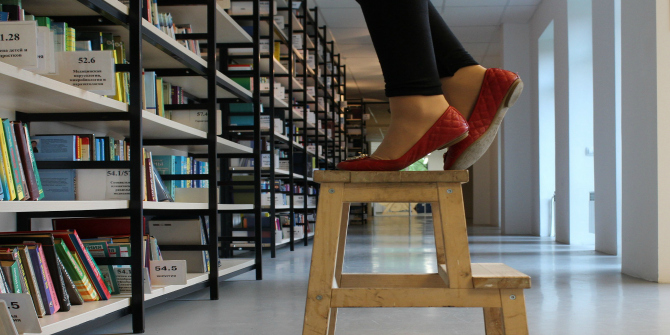In Experiences of Academics from a Working-Class Heritage, Carole Binns draws on interviews with fourteen tenured academics from a working-class background to reveal the complexities faced by individuals who have experienced social mobility in academia. Suggesting that a diversification of the academic workforce could be a valuable addition to the widening participation agenda, this book contributes to understanding lived experiences of social mobility and the social class inequalities that shape entry into ‘elite’ occupations, writes Ross Goldstone.
Experiences of Academics from a Working-Class Heritage: Ghosts of Childhood Habitus. Carole Binns. Cambridge Scholars Publishing. 2019.
 In Experiences of Academics from a Working-Class Heritage: Ghosts of Childhood Habitus, Carole Binns explores fourteen individual stories of social mobility, where individuals from a working-class heritage have ascended ‘the social ladder both in educational and career terms’ to enter the middle-class milieu of academia (3). Drawing upon qualitative data collected from these tenured academics, all of whom were employed at a single teaching-intensive UK university in the roles of Professor, Senior Lecturer or Lecturer, Binns discusses the lived experiences of being an academic from a working-class heritage. In doing so, she contributes to recent debates surrounding social mobility in the UK through demonstrating the complexity inherent in the process of ‘social climbing’.
In Experiences of Academics from a Working-Class Heritage: Ghosts of Childhood Habitus, Carole Binns explores fourteen individual stories of social mobility, where individuals from a working-class heritage have ascended ‘the social ladder both in educational and career terms’ to enter the middle-class milieu of academia (3). Drawing upon qualitative data collected from these tenured academics, all of whom were employed at a single teaching-intensive UK university in the roles of Professor, Senior Lecturer or Lecturer, Binns discusses the lived experiences of being an academic from a working-class heritage. In doing so, she contributes to recent debates surrounding social mobility in the UK through demonstrating the complexity inherent in the process of ‘social climbing’.
This book has been written during a time of Higher Education (HE) massification in the UK, where over half of all young people now pursue a university-level education. This growth in HE participation is due to increasing numbers of ‘non-traditional’ student populations entering disproportionately ‘new’ universities as part of the widening participation agenda (25). However, whilst the diversification of the student population has ‘triggered academics to review their teaching styles, delivery methods, learning materials, modes of assessment and often by listening to the student voice’ (27), there has been less significant change in the academic workforce, particularly in more ‘elite’ institutions. In this context, Binns aims to understand ‘the lived experiences of the interviewees’ (51) to reveal the complexities faced by individuals who have experienced social mobility in academia.

The book begins with a chapter setting the context for this study by outlining prior literature on the constitution of the academy and the UK HE sector. Chapter Two develops this context-setting by detailing the widening participation agenda in UK HE, and ponders the importance of academics from a working-class heritage to this policy. In Chapter Three, Binns describes the sample of academics participating in the study and details their social class background. During this chapter there is a conceptual discussion where definitions of social class are introduced, with specific reference to the scholarship of Pierre Bourdieu, which is drawn on throughout the following three empirical chapters. In these chapters, Binns discusses findings related to interviewees’ educational career and university experiences (Chapter Four), entry into academia and subsequent trajectory (Chapter Five) and experiences of academia as an academic from a working-class heritage (Chapter Six). In Chapter Six, there is a focus on two emergent analytical themes: firstly, networking; and secondly, the impact of a working-class heritage on engagements with students. This is followed by concluding remarks and a short reflective epilogue.
It is Binns’s concluding discussion in Chapter Seven that will form the remaining discussion of this book review, not only because this section pulls together the central themes running through the book, but also because it thinks more conceptually using the ideas of Bourdieu. In this chapter, interviewees are categorised into three groups, depending on their reconciliation of their originary working-class identity with their contemporary middle-class occupation. The first group is those who had ‘moved considerably away from the original working-class background [… and] saw themselves as middle-class nowadays’. The second group concerns those who ‘comfortably straddled the two classes […but] occasionally, were not sure which class group they belonged to’. The third group is those who ‘found the process of social mobility to be painful’ and generally ‘considered themselves to be working-class despite their educational and professional achievements’ (106).
Over half of the interviewees recalled a number of negative experiences in their teenage years, either at home or in education, which Binns believes functions similarly to a ‘capital’. Unlike Bourdieu’s notion of capital(s) as convertible, advantageous resources in a number of social fields, this capital ‘appears to have had a reverse influence upon the interviewees’ future academic experiences’ (107). For these academics, particularly those in the second and third groups, a ‘cleft habitus’ had developed and the ‘ghosts of habitus’ reappeared throughout their transition and progression through academia. This involves an academic’s habitus becoming split between their original working-class habitus and present middle-class habitus as a result of social mobility. Thus, at the same time as experiencing several positive outcomes associated with entering a middle-class occupation – increased levels of economic and cultural capital, for instance – there was a simultaneous emotional ambivalence and consciousness of their social mobility.
Despite the three groups’ different experiences of social mobility, there were three shared experiences of academia across the cohort. These related to external networking; not wanting to move from their current institution; and interactions with working-class students (110). Only one interviewee did not express an unease regarding external networking activities. While many explained that they did perform these duties, there was discomfort with the artificial and strategic nature of such encounters. Another almost universal finding was a reluctance to leave one’s current institution and secure employment at a more ‘elite’ institution (112). Binns explains that although a small number of interviewees did expect this to happen in the future, most prioritised personal comfort and wellbeing alongside career progression.
The finding that the interviewed academics from a working-class heritage could instinctively recognise working-class students is very relevant to the book’s earlier discussion of the widening participation agenda in UK HE. The interviewees spoke of the role their background played in helping them to support and develop a rapport with working-class students. Although Binns does note that these qualities ‘do not only belong to academics from a working-class background’ (114), she does suggest that a diversification of the academic workforce could be a useful addition to the widening participation agenda.
In writing this book on the experiences of academics from a working-class heritage, Binns is able to contribute to a relatively under-researched area and also supplements recent research on social mobility and social class inequalities in entry into ‘elite’ occupations. In doing so, the policy of encouraging students from ‘non-traditional’ backgrounds to enter HE is problematised, showing that ‘the concept of ‘‘inclusivity’’ is not always understood ‘‘on the other side’’’ (116). While inequalities relating to ethnicity and gender were not the focus, this book does suggest that further research is necessary to explore different experiences of the academy, especially, as Binns argues, because more working-class graduates, and other ‘non-traditional’ groups, are ‘likely to consider opting to stay in higher education for advanced study and possibly a career in higher education’ (117).
Note: This review gives the views of the author, and not the position of the LSE Review of Books blog, or of the London School of Economics.
Photo by Joshua Hoehne on Unsplash.







